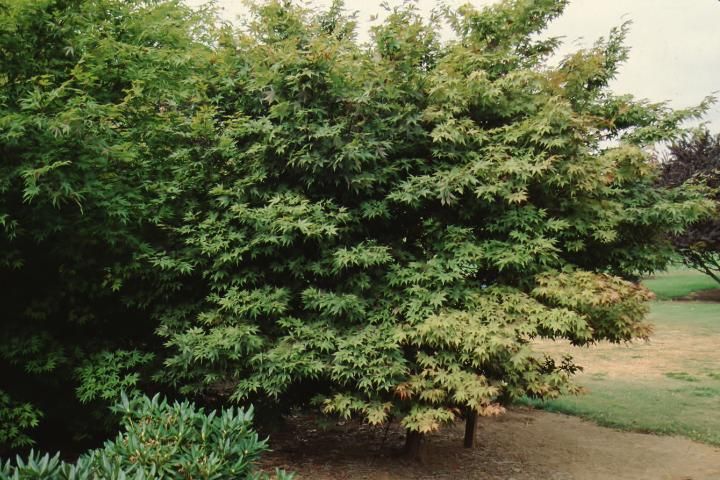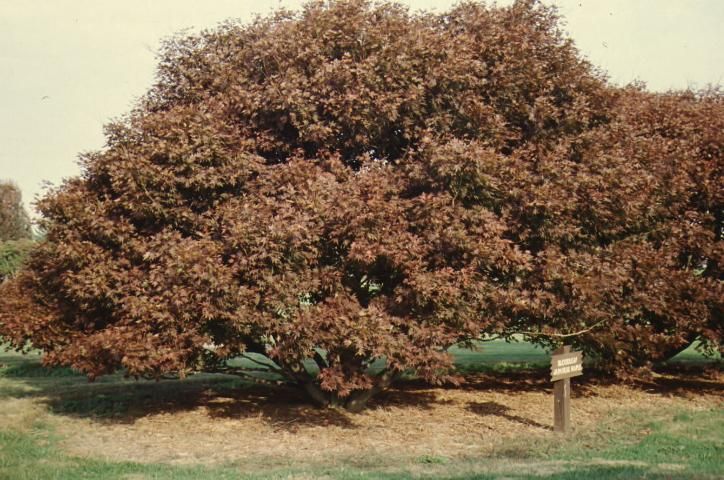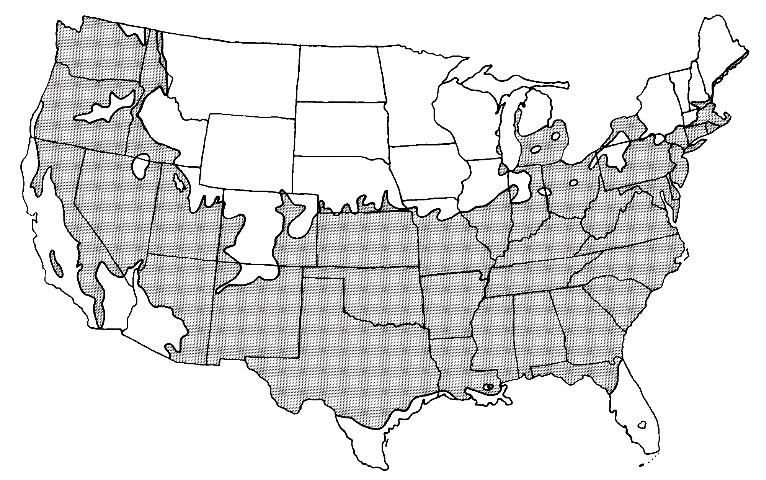Acer palmatum 'Bloodgood' Bloodgood Japanese Maple
Introduction
'Bloodgood' Japanese maple has a round shape with a height and spread of about 20 feet, making it nicely suited to residential landscapes. Its popularity is due mostly to the leaves, which stay red for most of the summer. Leaves turn greenish red during hot weather in the southern part of its range. The multiple trunks are muscular-looking, picturesque, grey and show nicely when lighted at night. Fall color is reddish and less striking than other Japanese maples. The globose canopy shape looks best when it is allowed to branch to the ground. Lower foliage branches can be thinned to display the attractive bark and trunk structure.

Credit: Ed Gilman, UF/IFAS

Credit: Ed Gilman, UF/IFAS
General Information
Scientific name: Acer palmatum 'Bloodgood'
Pronunciation: AY-sir pal-MAY-tum
Common name(s): 'Bloodgood' Japanese maple
Family: Aceraceae
Plant type: shrub
USDA hardiness zones: 5B through 8 (Figure 3)
Planting month for zone 7: year round
Planting month for zone 8: year round
Origin: not native to North America
Invasive potential: not known to be invasive
Uses: border; near a deck or patio; bonsai; container or above-ground planter; trained as a standard
Availability: generally available in many areas within its hardiness range

Description
Height: 12 to 20 feet
Spread: 15 to 20 feet
Plant habit: round
Plant density: symmetrical habit with a regular (or smooth) outline and individuals having more or less identical forms
Growth rate: slow
Texture: medium
Foliage
Leaf arrangement: opposite/subopposite
Leaf type: simple
Leaf margin: serrate; parted
Leaf shape: star-shaped
Leaf venation: palmate
Leaf type and persistence: deciduous
Leaf blade length: 2 to 4 inches
Leaf color: purple or red
Fall color: red
Fall characteristic: showy
Flower
Flower color: red
Flower characteristic: spring flowering
Fruit
Fruit shape: elongated
Fruit length: 1/2 to 1 inch
Fruit cover: dry or hard
Fruit color: red
Fruit characteristic: showy
Trunk and Branches
Trunk/bark/branches: no thorns; typically multi-trunked or clumping stems
Current year stem/twig color: reddish
Current year stem/twig thickness: thin
Culture
Light requirement: plant grows in the shade; plant grows in full sun
Soil tolerances: slightly alkaline; acidic; clay; loam; sand
Drought tolerance: moderate
Soil salt tolerance: moderate
Plant spacing: 36 to 60 inches
Other
Roots: usually not a problem
Winter interest: plant has winter interest due to unusual form, nice persistent fruits, showy winter trunk, or winter flowers
Outstanding plant: not particularly outstanding
Pest resistance: long-term health usually not affected by pests
Use and Management
This large shrub or small tree tends to leaf out early, so it may be injured by spring frosts. Leaves can scorch in hot summer weather unless they are in some shade or irrigated during dry weather. More direct sun can be tolerated in the northern part of the range. Be sure drainage is maintained, and never allow water to stand around the roots. Japanese maples grow well on clay soils as long as the ground is sloped so that water does not accumulate in the soil. They respond well to several inches of mulch placed beneath the canopy. Be sure to clear all turf away from beneath the branches of low-growing types so lawn mowers will not damage the tree.
This cultivar makes a nice patio or small shade tree for residential lots and, with pruning to remove drooping branches, provides adequate clearance for pedestrian traffic to pass close to the tree.
Train the trunks and branches so that they will not touch each other. Eliminate branches with included (embedded) bark or those that are likely to develop it as soon as possible. This reduces the likelihood of a branch splitting from the tree later when it has grown to become an important part of the landscape. Remove small twigs to enhance the showy trunk and bark structure. Locate the tree properly; take into account the ultimate size because the tree looks best if it is not pruned to control size. It can be the centerpiece of your landscape if it is properly located. Japanese maples have a reputation for transplanting from a field nursery poorly, but root-pruned plants and those from containers should do well.
Design Considerations
As a specimen plant the Bloodgood Japanese maple should be located to create a focal point. Background plants should have a simple form and full foliage to create a solid mass that highlights the form of the maple. Low-growing shrubs and groundcover plants with light or medium green, glossy leaves would contrast well with the reddish color foliage of the maple. Pair with low-growing plants with simple forms and fine texture such as mounding grasses with narrow strap blades or the sprawling/mounding forms of juniper with fine little needles. White or pink flowers in surrounding plants will highlight the red foliage. Low-growing plants at the base will allow the attractive bark and multiple trunks show in trimmed trees.
Pests and Diseases
Due to poor growth in poorly drained soil, Japanese maples are often planted on raised beds or on high ground in clay soil. Aphids, scales and borers can be found on the maples. Scorch occurs during periods of high temperatures accompanied by wind. Trees with diseased or inadequate root systems will also show scorching. Verticillium wilt can kill plants.


